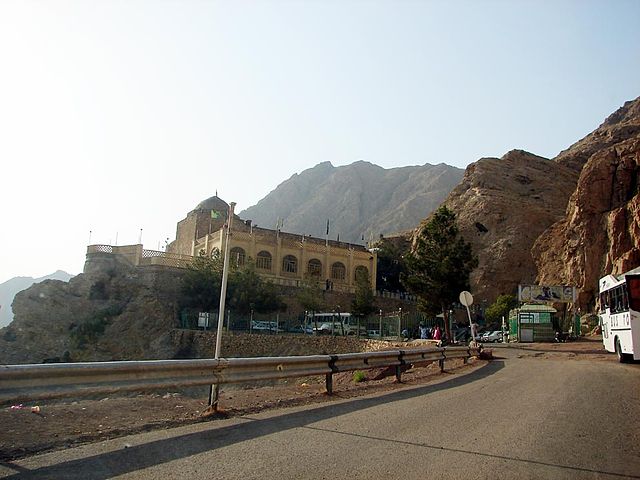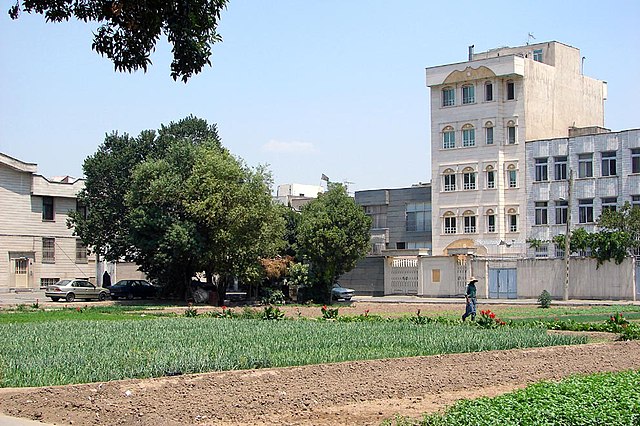
| REY, IRAN
Ray, Iran
Tughrul Tower
Shah Abdol-Azim Shrine
Rey Castle
Bahram Fire Temple
Rashkan Castle
Bibi Shahrbanu Shrine (Shahrbanu, Mehrbanu and Hussani Brahmins) Country
: Iran
Shahr-e Rey (Persian: "City of Ray") or simply Ray is the capital of Ray County in Tehran Province, Iran. Formerly a distinct city, it has now been absorbed into the metropolitan area of Greater Tehran as the 20th district of municipal Tehran, the capital city of the country.
Historically known as Rhages, Rhagae and Arsacia, Ray is the oldest existing city in Tehran Province. In the classical era, it was a prominent city belonging to Media, the political and cultural base of the Medes. Ancient Persian inscriptions and the Avesta (Zoroastrian scriptures), among other sources, attest to the importance of ancient Ray. Ray is mentioned several times in the Apocrypha. It is also shown on the 4th-century Peutinger Map. The city was subject to severe destruction during the medieval invasions by the Arabs, Turks, and Mongols. Its position as a capital city was revived during the reigns of the Buyid Daylamites and the Seljuk Turks. Ray is richer than many other ancient cities in the number of its historical monuments. The Neolithic site of Cheshme-Ali, the reconstructed Median-era Rey Castle, the Parthian-era Rashkan Castle, the Sasanian-era Zoroastrian Fire Temple of Bahram, and the once Zoroastrian and now Islamic Shrine of Bibi Shahrbanu are among the many archaeological sites in Ray.
Ray has been home to many historical figures, including royalty, merchants, scholars and poets. Medieval Persian scholar Rhazes, one of the most important figures in medical science, was from Ray. One of the etymologies proposed for the name of the Radhanites—a group of merchants, some of Jewish origin, who kept open the Eurasian trade routes in the early Middle Ages—links them to Ray.
Ray today has many industries and factories in operation. It is connected via the rapid transit system of Tehran Metro to the rest of Greater Tehran.
Name
:
The name is spelled in various forms, including Ray, Rey, Rayy and Rhay. Encyclopædia Iranica uses Ray.
The nisba of this place of origin is Al-Razi or Râzi.
History
:
Classical
era :
Ray was one of the main strongholds of the Seleucid Empire. During the Seleucid period, Alexander the Great's general Seleucus I Nicator renamed the city as Europos, honoring his home city in Macedonia. Ray was used as one of the shifting capitals of the Parthian Empire, according to Athenaeus. According to Isidore of Charax, under the Parthian and Seleucid eras, Ray was surrounded by the province of Rhagiana together with four other cities.
The Bahram Fire Temple (Teppe Mill) is a Zoroastrian fire temple from the time of the Sasanian Empire in Ray, Iran Under the Sasanian Empire, Ray was located near the center of the empire. It was the base of the powerful House of Mehran and the House of Spandiyad, two of the Seven Great Houses of Iran during the Sasanian period.
Middle
Ages :
The Shah Abdol-Azim Shrine, a shrine containing the tomb of Abd al-Aziz al-Hasani, a fifth generation descendant of Hasan ibn Ali and a companion of Muhammad al-Taqi, was built in the 9th century. It remains as the main Islamic sanctuary of the city to date.
A Tower of Silence, where Zoroastrians of after the Muslim conquest had come to put the bodies of the dead in the open, was built by a wealthy inhabitant of Ray on a hill in the 10th century. The tower, today in ruins and designated as Gabri (a term denoting "Zoroastrian", adopted after the Muslim conquest), was reportedly soon taken by the Muslims.
Also dating to the 10th century is the Bibi Shahrbanu Shrine, which is the site of a former Zoroastrian temple dedicated to Anahita, the ancient Iranian goddess of the waters. The temple has been converted into a Muslim shrine claimed to be the burial of Shahrbanu, a legendary Sasanian princess who was captured by the Muslims and married Husayn ibn Ali, the grandson of Muhammad, the founder of Islam. It is likely that the name shahrbanu, meaning "lady of the land", is in fact an attribution to Anahita, who bore the title banu ("lady").
Ray was one of the capital cities of the Buyid dynasty. It was one of the cities that were equipped with rapid postal service, which was predominantly used for transferring official mails.
The 12th-century Seljuk-era Tughrul Tower in Ray, Iran Ray was also a capital city of the Seljuk Empire in the 11th century. During this time, the city of Ray was at its greatest expanse. It had developed a great urban market that also benefited its neighboring regions, including the once small town of Tehran, and had become a remarkable center for silk weaving. Commercial goods imported by traders via the Silk Road were brought into the bazaar of Ray. One of the monuments that survives from this period is the 12th-century Tughrul Tower, a brick tower built in 1140 that is attributed to Tughrul I, the founder of the Seljuk Empire.
Ray was home to a Shia Muslim community and some of the earliest Shia madrasas in Iran already in the 12th century, at least one established by Shia scholar Qazvini Razi, prior to the later Safavid official adoption of Shiism as the state religion.
Naghare-khane, a structure identified as a tomb from before the Mongol invasion, located outside the old city walls of Ray In the early 13th century, following the Mongol invasion of Iran, Ray was severely destructed. It was abandoned and eventually lost its importance in the presence of the nearby growing town of Tehran. Ray remained abandoned throughout the time of the Timurid Empire.
Early modern times :
The Qajar-era Fath Ali Shah Inscription at Cheshme-Ali, Ray Amin Razi, a Persian geographer from Ray who lived by the time of the Safavid dynasty, attests to the "incomparable abundance" of the gardens and canals of his hometown. In 1618, Italian author Pietro Della Valle described Ray as a large city with large gardens that was administrated by a provincial governor but was not urbanized and didn't seem to be inhabited.
The shrines of Shah Abdol-Azim and Bibi Shahrbanu, among other religious shrines throughout Iran, were notably reconstructed during the early modern period, using architectural techniques that were developed since the time of the Safavid dynasty to the time of the Qajar dynasty.
There is a relief located at Cheshme-Ali from the time of Fath-Ali Shah of the Qajar dynasty, who often used to explore the city, which shows the Qajar ruler in a hunting scene, replacing a former Sasanian relief that depicted an ancient Persian emperor in the same manner. It was engraved in 1831, and its surrounding was decorated with tablets covered with poetry.
Contemporary era :
An old locomotive that connected Tehran and Ray on one of Iran's earliest railways In the middle of the 19th century, Ray was described as a place of ruins, the only settlement being around the Shah Abdol-Azim Shrine. Being the only important pilgrimage site in vicinity to the royal court in the new capital Tehran brought more people to visit the shrine and a major restoration was sponsored by the court. Thus, between the years 1886 and 1888, under the reign of Qajar ruler Naser al-Din Shah, Ray became the first place in Iran to be connected to the capital by a railway. The railway had a short single line and transported a few steam locomotives that were colloquially called mašin dudi ("smoky machine"), between terminals that were called gar (from French gare).
Excavations in the old city began in the late 19th century, and many of the findings were traded. Between 1933 and 1936, the Cheshme-Ali hill was excavated by archaeologists from the Boston Fine Arts Museum and the University Museum at the University of Pennsylvania headed by Erich Schmidt, which resulted in the discovery of a number of 7,000-year-old artifacts. Some of the discovered objects are displayed at museums in Iran, Chicago, and Philadelphia. Due to real estate expansions in the 1980s and 1990s, the hill is now mostly leveled out. Further excavations began in 1997, in a collaboration between the Iranian Ministry of Cultural Heritage, the Department of Archaeological Sciences of the University of Bradford and the Department of Archaeology of the University of Tehran.
The Mausoleum of Reza Shah in the 1950s prior to its destruction In 1951, Reza Shah of the Pahlavi dynasty, the second last shah of the Imperial State of Iran, was buried by the order of his son and successor Mohammad Reza Pahlavi in a mausoleum dedicated to him in Ray. The mausoleum was built near the Shah Abdol-Azim Shrine. Following the 1979 Revolution, the Mausoleum of Reza Shah was destroyed under the direction of Sadegh Khalkhali, an infamous cleric who was appointed by Ruhollah Khomeini as the head of the newly established Revolutionary Courts.
Notable
people :
A 1818 map of Ray by Scottish traveler Robert Ker Porter
A 1840 depiction of the 12th-century Seljuk-era Tughrul Tower of Ray by French orientalist Eugène Flandin
A 1840 depiction of Cheshme-Ali in Ray by French orientalist Eugène Flandin
A 1860 depiction of Ray by French orientalist Jules Laurens
People spreading washed carpets to dry at Cheshme-Ali in 1960
Growing vegetables in a residential area in Ray
Shahr-e-Rey Metro Station, part of the rapid transit system of Tehran Metro
The clock tower of the Shah Abdol-Azim Shrine in Ray
Ibn Babawayh Cemetery, named after Shia scholar Ibn Babawayh, in Ray
Source :
https://en.wikipedia.org/ |

.jpg)
.jpg)
















_(15025618305).jpg)
_(15002619346).jpg)
